MBA Case Study: Corporate Social Responsibility - Deepwater Horizon
VerifiedAdded on 2019/09/25
|18
|3779
|339
Case Study
AI Summary
This case study delves into the Deepwater Horizon oil spill, a pivotal event in the petroleum industry marked by the largest maritime disaster in history. The assignment requires a comprehensive analysis of the crisis, examining the corporate social responsibility (CSR) aspects across various business functions. It explores the economic repercussions on BP, the oil industry, the community, and the government, while also detailing the environmental impact on different ecological systems. Furthermore, the case study investigates the effects on the community, including local businesses, the labor force, and potential health hazards. The assignment also tasks the student with proposing environmental initiatives, community support plans, potential CSR projects, and identifying risks that could threaten the company's position, relating them to corresponding stakeholders. The student is required to answer specific questions, provide an executive summary, and adhere to strict referencing guidelines. The assignment serves as a critical evaluation of CSR practices and risk management in the context of a major environmental disaster.

Master of Business Administration
Corporate Social Responsibilities
(Deep Water Horizon Case Study)
PRESENTATION OF FINAL ASSIGNMENT
You must include a title page that lists your name, Student ID and the unit number and title.
Number all pages sequentially.
Any published material you refer to must be properly referenced (Harvard Referencing) and
included in a reference list at the end of your assignment.
The Harvard Referencing System; e.g. 'Smith (1985) listed five key factors'
NOTE: The first page of each final case study must include the following declaration:
I certify that this assignment is my own work, based on my personal study and/or research, and that I have
acknowledged all material and sources used in the preparation of this final case study whether they be
books, articles, reports, lecture notes, any other kind of document, electronic or personal communication.
I also certify that the final case study has not previously been submitted for assessment in any other course
or at any other time in this Course, unless by negotiation, and that I have not copied in part or whole or
otherwise plagiarised the work of other students and/or persons. I have read the GBS policy on plagiarism
and understand its implications.
Final case study that do not include the above declaration will not be marked.
FINAL CASE STUDY
Corporate Social Responsibilities
(Deep Water Horizon Case Study)
PRESENTATION OF FINAL ASSIGNMENT
You must include a title page that lists your name, Student ID and the unit number and title.
Number all pages sequentially.
Any published material you refer to must be properly referenced (Harvard Referencing) and
included in a reference list at the end of your assignment.
The Harvard Referencing System; e.g. 'Smith (1985) listed five key factors'
NOTE: The first page of each final case study must include the following declaration:
I certify that this assignment is my own work, based on my personal study and/or research, and that I have
acknowledged all material and sources used in the preparation of this final case study whether they be
books, articles, reports, lecture notes, any other kind of document, electronic or personal communication.
I also certify that the final case study has not previously been submitted for assessment in any other course
or at any other time in this Course, unless by negotiation, and that I have not copied in part or whole or
otherwise plagiarised the work of other students and/or persons. I have read the GBS policy on plagiarism
and understand its implications.
Final case study that do not include the above declaration will not be marked.
FINAL CASE STUDY
Paraphrase This Document
Need a fresh take? Get an instant paraphrase of this document with our AI Paraphraser
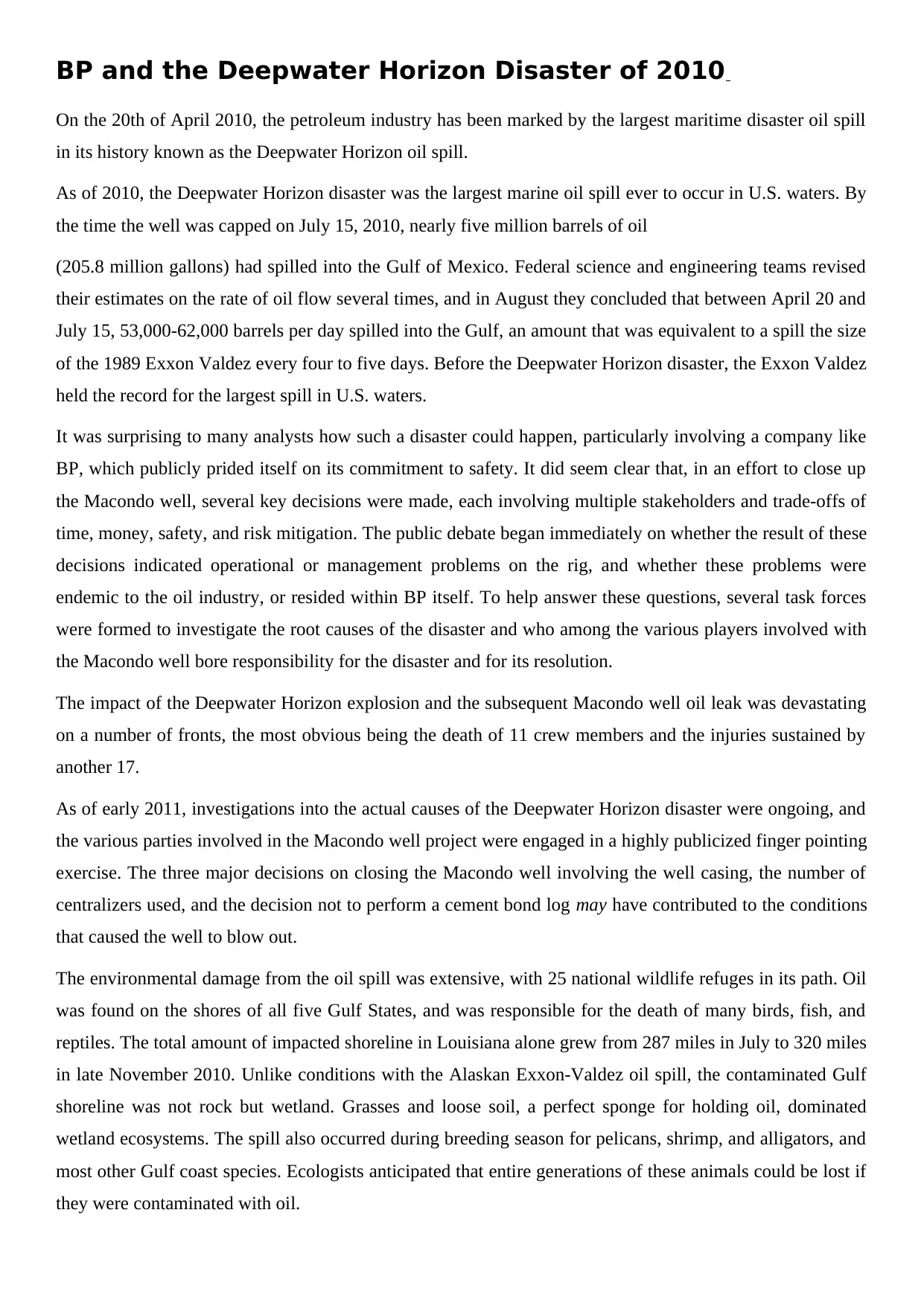
BP and the Deepwater Horizon Disaster of 2010
On the 20th of April 2010, the petroleum industry has been marked by the largest maritime disaster oil spill
in its history known as the Deepwater Horizon oil spill.
As of 2010, the Deepwater Horizon disaster was the largest marine oil spill ever to occur in U.S. waters. By
the time the well was capped on July 15, 2010, nearly five million barrels of oil
(205.8 million gallons) had spilled into the Gulf of Mexico. Federal science and engineering teams revised
their estimates on the rate of oil flow several times, and in August they concluded that between April 20 and
July 15, 53,000-62,000 barrels per day spilled into the Gulf, an amount that was equivalent to a spill the size
of the 1989 Exxon Valdez every four to five days. Before the Deepwater Horizon disaster, the Exxon Valdez
held the record for the largest spill in U.S. waters.
It was surprising to many analysts how such a disaster could happen, particularly involving a company like
BP, which publicly prided itself on its commitment to safety. It did seem clear that, in an effort to close up
the Macondo well, several key decisions were made, each involving multiple stakeholders and trade-offs of
time, money, safety, and risk mitigation. The public debate began immediately on whether the result of these
decisions indicated operational or management problems on the rig, and whether these problems were
endemic to the oil industry, or resided within BP itself. To help answer these questions, several task forces
were formed to investigate the root causes of the disaster and who among the various players involved with
the Macondo well bore responsibility for the disaster and for its resolution.
The impact of the Deepwater Horizon explosion and the subsequent Macondo well oil leak was devastating
on a number of fronts, the most obvious being the death of 11 crew members and the injuries sustained by
another 17.
As of early 2011, investigations into the actual causes of the Deepwater Horizon disaster were ongoing, and
the various parties involved in the Macondo well project were engaged in a highly publicized finger pointing
exercise. The three major decisions on closing the Macondo well involving the well casing, the number of
centralizers used, and the decision not to perform a cement bond log may have contributed to the conditions
that caused the well to blow out.
The environmental damage from the oil spill was extensive, with 25 national wildlife refuges in its path. Oil
was found on the shores of all five Gulf States, and was responsible for the death of many birds, fish, and
reptiles. The total amount of impacted shoreline in Louisiana alone grew from 287 miles in July to 320 miles
in late November 2010. Unlike conditions with the Alaskan Exxon-Valdez oil spill, the contaminated Gulf
shoreline was not rock but wetland. Grasses and loose soil, a perfect sponge for holding oil, dominated
wetland ecosystems. The spill also occurred during breeding season for pelicans, shrimp, and alligators, and
most other Gulf coast species. Ecologists anticipated that entire generations of these animals could be lost if
they were contaminated with oil.
On the 20th of April 2010, the petroleum industry has been marked by the largest maritime disaster oil spill
in its history known as the Deepwater Horizon oil spill.
As of 2010, the Deepwater Horizon disaster was the largest marine oil spill ever to occur in U.S. waters. By
the time the well was capped on July 15, 2010, nearly five million barrels of oil
(205.8 million gallons) had spilled into the Gulf of Mexico. Federal science and engineering teams revised
their estimates on the rate of oil flow several times, and in August they concluded that between April 20 and
July 15, 53,000-62,000 barrels per day spilled into the Gulf, an amount that was equivalent to a spill the size
of the 1989 Exxon Valdez every four to five days. Before the Deepwater Horizon disaster, the Exxon Valdez
held the record for the largest spill in U.S. waters.
It was surprising to many analysts how such a disaster could happen, particularly involving a company like
BP, which publicly prided itself on its commitment to safety. It did seem clear that, in an effort to close up
the Macondo well, several key decisions were made, each involving multiple stakeholders and trade-offs of
time, money, safety, and risk mitigation. The public debate began immediately on whether the result of these
decisions indicated operational or management problems on the rig, and whether these problems were
endemic to the oil industry, or resided within BP itself. To help answer these questions, several task forces
were formed to investigate the root causes of the disaster and who among the various players involved with
the Macondo well bore responsibility for the disaster and for its resolution.
The impact of the Deepwater Horizon explosion and the subsequent Macondo well oil leak was devastating
on a number of fronts, the most obvious being the death of 11 crew members and the injuries sustained by
another 17.
As of early 2011, investigations into the actual causes of the Deepwater Horizon disaster were ongoing, and
the various parties involved in the Macondo well project were engaged in a highly publicized finger pointing
exercise. The three major decisions on closing the Macondo well involving the well casing, the number of
centralizers used, and the decision not to perform a cement bond log may have contributed to the conditions
that caused the well to blow out.
The environmental damage from the oil spill was extensive, with 25 national wildlife refuges in its path. Oil
was found on the shores of all five Gulf States, and was responsible for the death of many birds, fish, and
reptiles. The total amount of impacted shoreline in Louisiana alone grew from 287 miles in July to 320 miles
in late November 2010. Unlike conditions with the Alaskan Exxon-Valdez oil spill, the contaminated Gulf
shoreline was not rock but wetland. Grasses and loose soil, a perfect sponge for holding oil, dominated
wetland ecosystems. The spill also occurred during breeding season for pelicans, shrimp, and alligators, and
most other Gulf coast species. Ecologists anticipated that entire generations of these animals could be lost if
they were contaminated with oil.
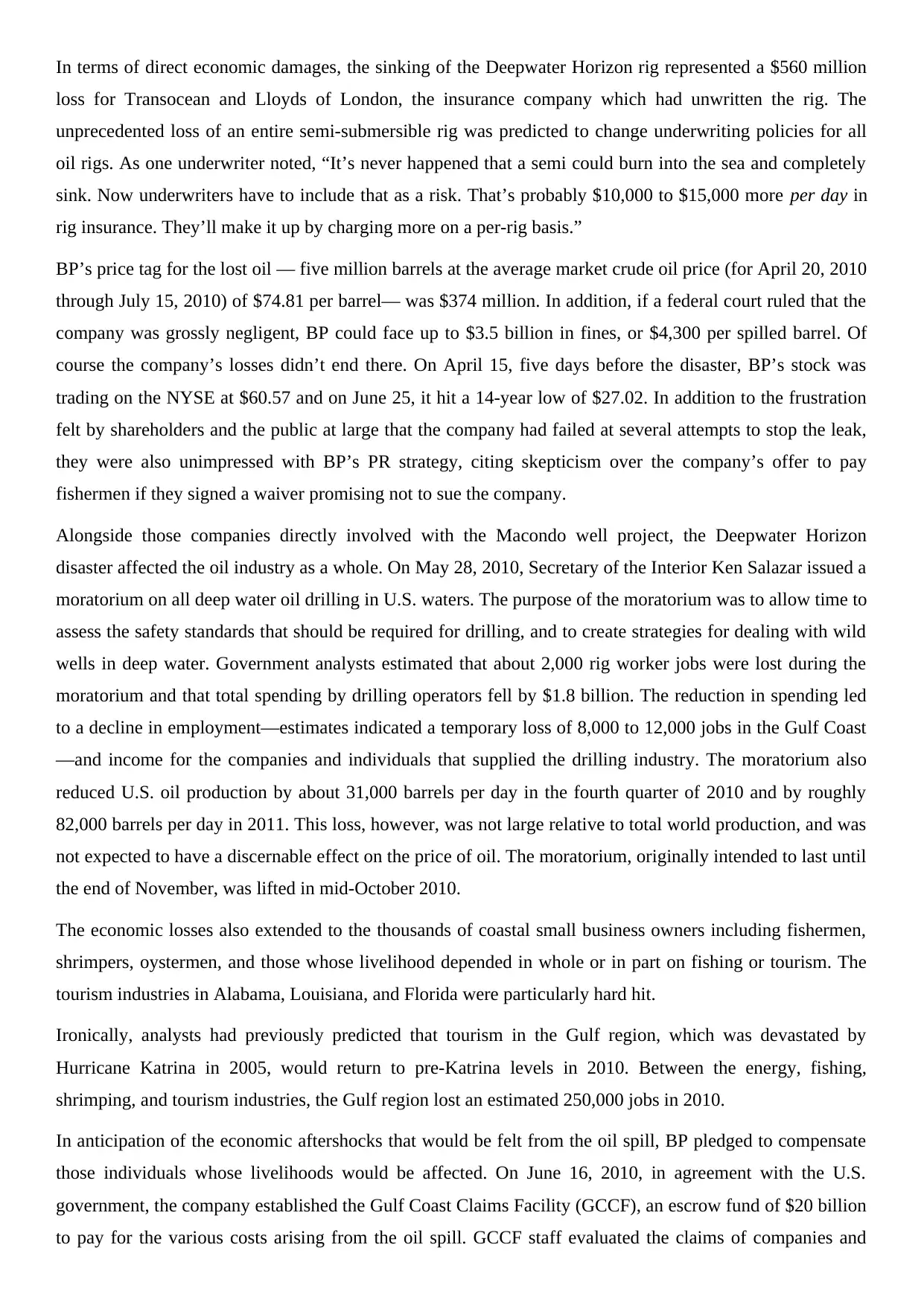
In terms of direct economic damages, the sinking of the Deepwater Horizon rig represented a $560 million
loss for Transocean and Lloyds of London, the insurance company which had unwritten the rig. The
unprecedented loss of an entire semi-submersible rig was predicted to change underwriting policies for all
oil rigs. As one underwriter noted, “It’s never happened that a semi could burn into the sea and completely
sink. Now underwriters have to include that as a risk. That’s probably $10,000 to $15,000 more per day in
rig insurance. They’ll make it up by charging more on a per-rig basis.”
BP’s price tag for the lost oil — five million barrels at the average market crude oil price (for April 20, 2010
through July 15, 2010) of $74.81 per barrel— was $374 million. In addition, if a federal court ruled that the
company was grossly negligent, BP could face up to $3.5 billion in fines, or $4,300 per spilled barrel. Of
course the company’s losses didn’t end there. On April 15, five days before the disaster, BP’s stock was
trading on the NYSE at $60.57 and on June 25, it hit a 14-year low of $27.02. In addition to the frustration
felt by shareholders and the public at large that the company had failed at several attempts to stop the leak,
they were also unimpressed with BP’s PR strategy, citing skepticism over the company’s offer to pay
fishermen if they signed a waiver promising not to sue the company.
Alongside those companies directly involved with the Macondo well project, the Deepwater Horizon
disaster affected the oil industry as a whole. On May 28, 2010, Secretary of the Interior Ken Salazar issued a
moratorium on all deep water oil drilling in U.S. waters. The purpose of the moratorium was to allow time to
assess the safety standards that should be required for drilling, and to create strategies for dealing with wild
wells in deep water. Government analysts estimated that about 2,000 rig worker jobs were lost during the
moratorium and that total spending by drilling operators fell by $1.8 billion. The reduction in spending led
to a decline in employment—estimates indicated a temporary loss of 8,000 to 12,000 jobs in the Gulf Coast
—and income for the companies and individuals that supplied the drilling industry. The moratorium also
reduced U.S. oil production by about 31,000 barrels per day in the fourth quarter of 2010 and by roughly
82,000 barrels per day in 2011. This loss, however, was not large relative to total world production, and was
not expected to have a discernable effect on the price of oil. The moratorium, originally intended to last until
the end of November, was lifted in mid-October 2010.
The economic losses also extended to the thousands of coastal small business owners including fishermen,
shrimpers, oystermen, and those whose livelihood depended in whole or in part on fishing or tourism. The
tourism industries in Alabama, Louisiana, and Florida were particularly hard hit.
Ironically, analysts had previously predicted that tourism in the Gulf region, which was devastated by
Hurricane Katrina in 2005, would return to pre-Katrina levels in 2010. Between the energy, fishing,
shrimping, and tourism industries, the Gulf region lost an estimated 250,000 jobs in 2010.
In anticipation of the economic aftershocks that would be felt from the oil spill, BP pledged to compensate
those individuals whose livelihoods would be affected. On June 16, 2010, in agreement with the U.S.
government, the company established the Gulf Coast Claims Facility (GCCF), an escrow fund of $20 billion
to pay for the various costs arising from the oil spill. GCCF staff evaluated the claims of companies and
loss for Transocean and Lloyds of London, the insurance company which had unwritten the rig. The
unprecedented loss of an entire semi-submersible rig was predicted to change underwriting policies for all
oil rigs. As one underwriter noted, “It’s never happened that a semi could burn into the sea and completely
sink. Now underwriters have to include that as a risk. That’s probably $10,000 to $15,000 more per day in
rig insurance. They’ll make it up by charging more on a per-rig basis.”
BP’s price tag for the lost oil — five million barrels at the average market crude oil price (for April 20, 2010
through July 15, 2010) of $74.81 per barrel— was $374 million. In addition, if a federal court ruled that the
company was grossly negligent, BP could face up to $3.5 billion in fines, or $4,300 per spilled barrel. Of
course the company’s losses didn’t end there. On April 15, five days before the disaster, BP’s stock was
trading on the NYSE at $60.57 and on June 25, it hit a 14-year low of $27.02. In addition to the frustration
felt by shareholders and the public at large that the company had failed at several attempts to stop the leak,
they were also unimpressed with BP’s PR strategy, citing skepticism over the company’s offer to pay
fishermen if they signed a waiver promising not to sue the company.
Alongside those companies directly involved with the Macondo well project, the Deepwater Horizon
disaster affected the oil industry as a whole. On May 28, 2010, Secretary of the Interior Ken Salazar issued a
moratorium on all deep water oil drilling in U.S. waters. The purpose of the moratorium was to allow time to
assess the safety standards that should be required for drilling, and to create strategies for dealing with wild
wells in deep water. Government analysts estimated that about 2,000 rig worker jobs were lost during the
moratorium and that total spending by drilling operators fell by $1.8 billion. The reduction in spending led
to a decline in employment—estimates indicated a temporary loss of 8,000 to 12,000 jobs in the Gulf Coast
—and income for the companies and individuals that supplied the drilling industry. The moratorium also
reduced U.S. oil production by about 31,000 barrels per day in the fourth quarter of 2010 and by roughly
82,000 barrels per day in 2011. This loss, however, was not large relative to total world production, and was
not expected to have a discernable effect on the price of oil. The moratorium, originally intended to last until
the end of November, was lifted in mid-October 2010.
The economic losses also extended to the thousands of coastal small business owners including fishermen,
shrimpers, oystermen, and those whose livelihood depended in whole or in part on fishing or tourism. The
tourism industries in Alabama, Louisiana, and Florida were particularly hard hit.
Ironically, analysts had previously predicted that tourism in the Gulf region, which was devastated by
Hurricane Katrina in 2005, would return to pre-Katrina levels in 2010. Between the energy, fishing,
shrimping, and tourism industries, the Gulf region lost an estimated 250,000 jobs in 2010.
In anticipation of the economic aftershocks that would be felt from the oil spill, BP pledged to compensate
those individuals whose livelihoods would be affected. On June 16, 2010, in agreement with the U.S.
government, the company established the Gulf Coast Claims Facility (GCCF), an escrow fund of $20 billion
to pay for the various costs arising from the oil spill. GCCF staff evaluated the claims of companies and
⊘ This is a preview!⊘
Do you want full access?
Subscribe today to unlock all pages.

Trusted by 1+ million students worldwide
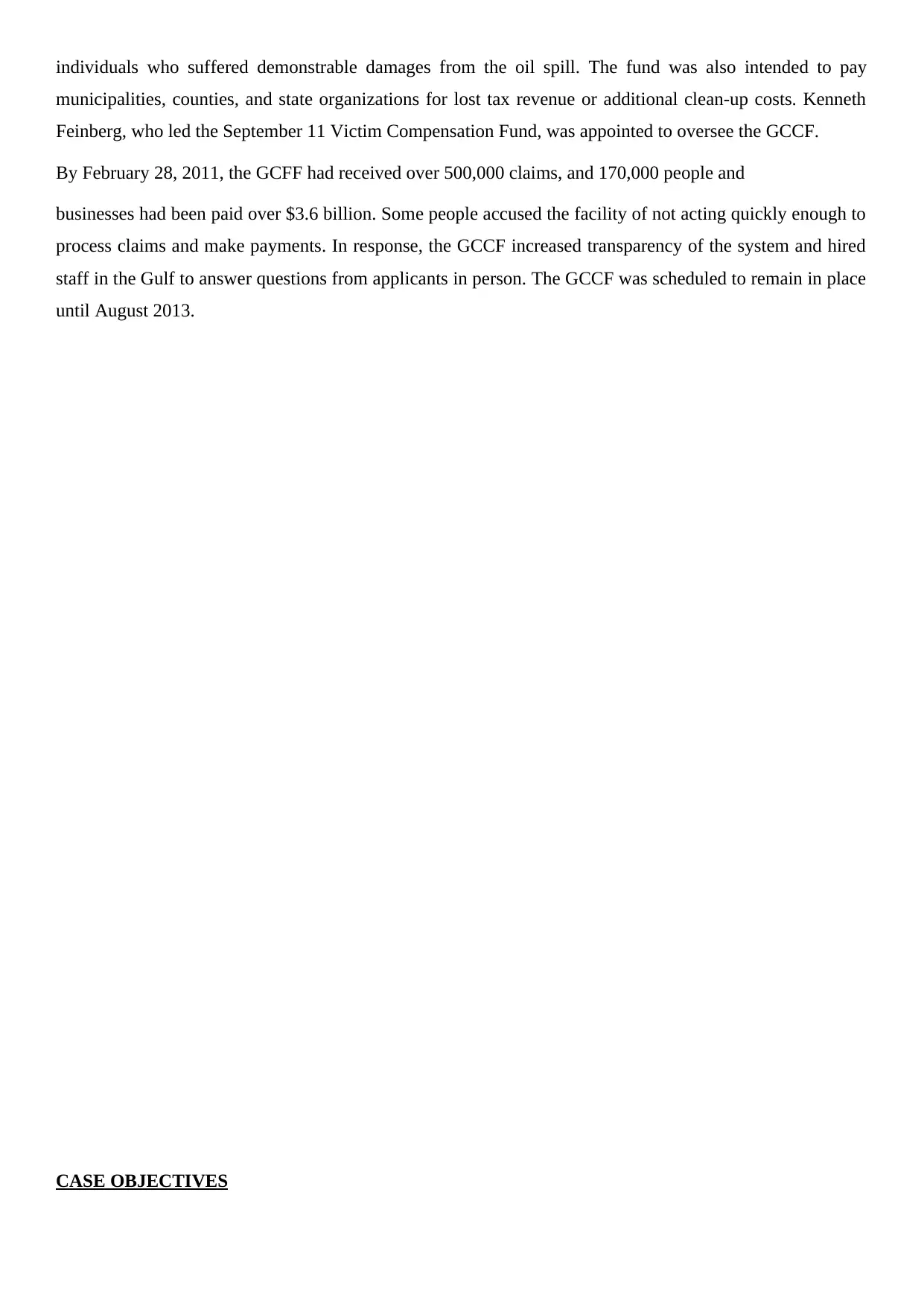
individuals who suffered demonstrable damages from the oil spill. The fund was also intended to pay
municipalities, counties, and state organizations for lost tax revenue or additional clean-up costs. Kenneth
Feinberg, who led the September 11 Victim Compensation Fund, was appointed to oversee the GCCF.
By February 28, 2011, the GCFF had received over 500,000 claims, and 170,000 people and
businesses had been paid over $3.6 billion. Some people accused the facility of not acting quickly enough to
process claims and make payments. In response, the GCCF increased transparency of the system and hired
staff in the Gulf to answer questions from applicants in person. The GCCF was scheduled to remain in place
until August 2013.
CASE OBJECTIVES
municipalities, counties, and state organizations for lost tax revenue or additional clean-up costs. Kenneth
Feinberg, who led the September 11 Victim Compensation Fund, was appointed to oversee the GCCF.
By February 28, 2011, the GCFF had received over 500,000 claims, and 170,000 people and
businesses had been paid over $3.6 billion. Some people accused the facility of not acting quickly enough to
process claims and make payments. In response, the GCCF increased transparency of the system and hired
staff in the Gulf to answer questions from applicants in person. The GCCF was scheduled to remain in place
until August 2013.
CASE OBJECTIVES
Paraphrase This Document
Need a fresh take? Get an instant paraphrase of this document with our AI Paraphraser
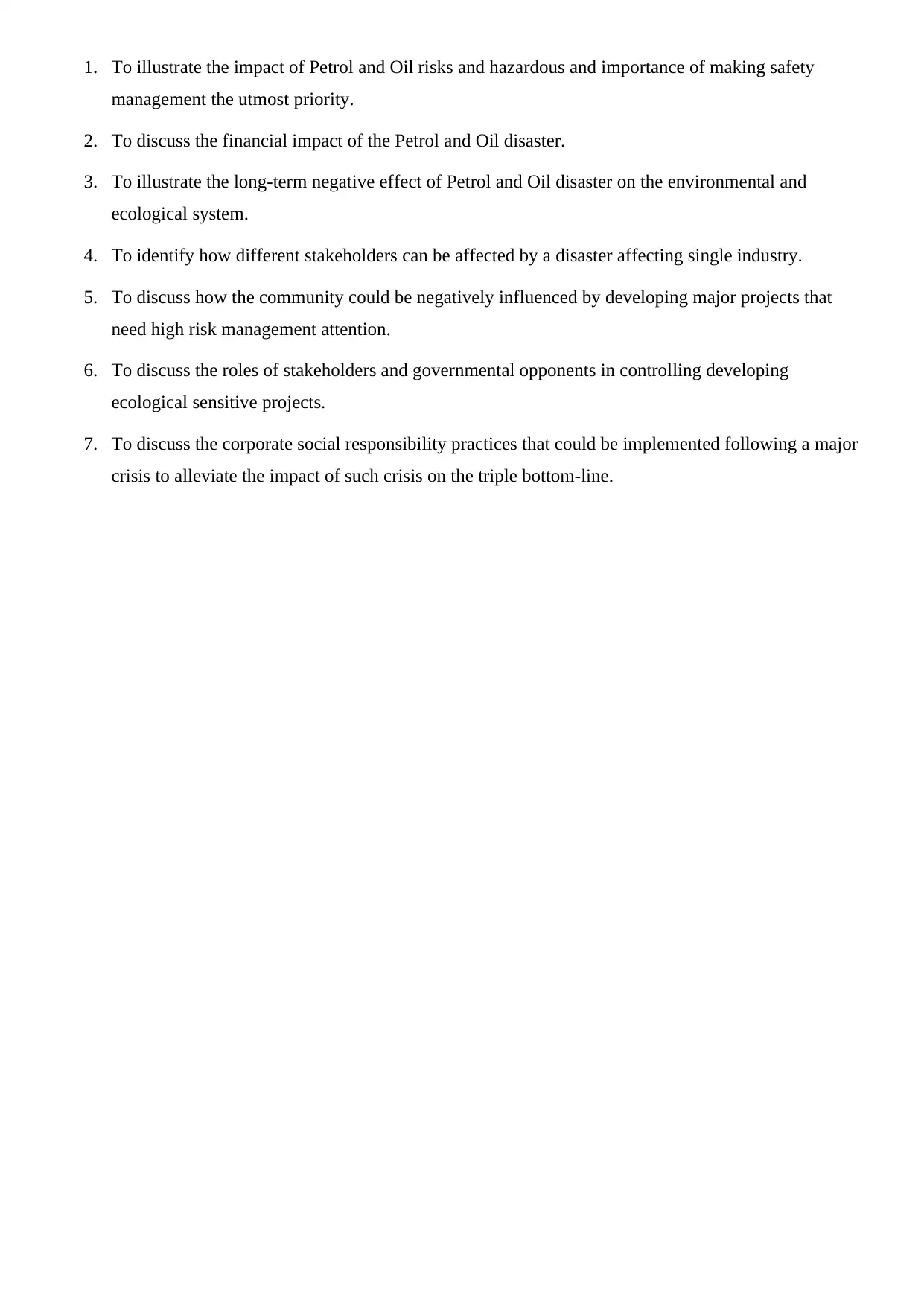
1. To illustrate the impact of Petrol and Oil risks and hazardous and importance of making safety
management the utmost priority.
2. To discuss the financial impact of the Petrol and Oil disaster.
3. To illustrate the long-term negative effect of Petrol and Oil disaster on the environmental and
ecological system.
4. To identify how different stakeholders can be affected by a disaster affecting single industry.
5. To discuss how the community could be negatively influenced by developing major projects that
need high risk management attention.
6. To discuss the roles of stakeholders and governmental opponents in controlling developing
ecological sensitive projects.
7. To discuss the corporate social responsibility practices that could be implemented following a major
crisis to alleviate the impact of such crisis on the triple bottom-line.
management the utmost priority.
2. To discuss the financial impact of the Petrol and Oil disaster.
3. To illustrate the long-term negative effect of Petrol and Oil disaster on the environmental and
ecological system.
4. To identify how different stakeholders can be affected by a disaster affecting single industry.
5. To discuss how the community could be negatively influenced by developing major projects that
need high risk management attention.
6. To discuss the roles of stakeholders and governmental opponents in controlling developing
ecological sensitive projects.
7. To discuss the corporate social responsibility practices that could be implemented following a major
crisis to alleviate the impact of such crisis on the triple bottom-line.
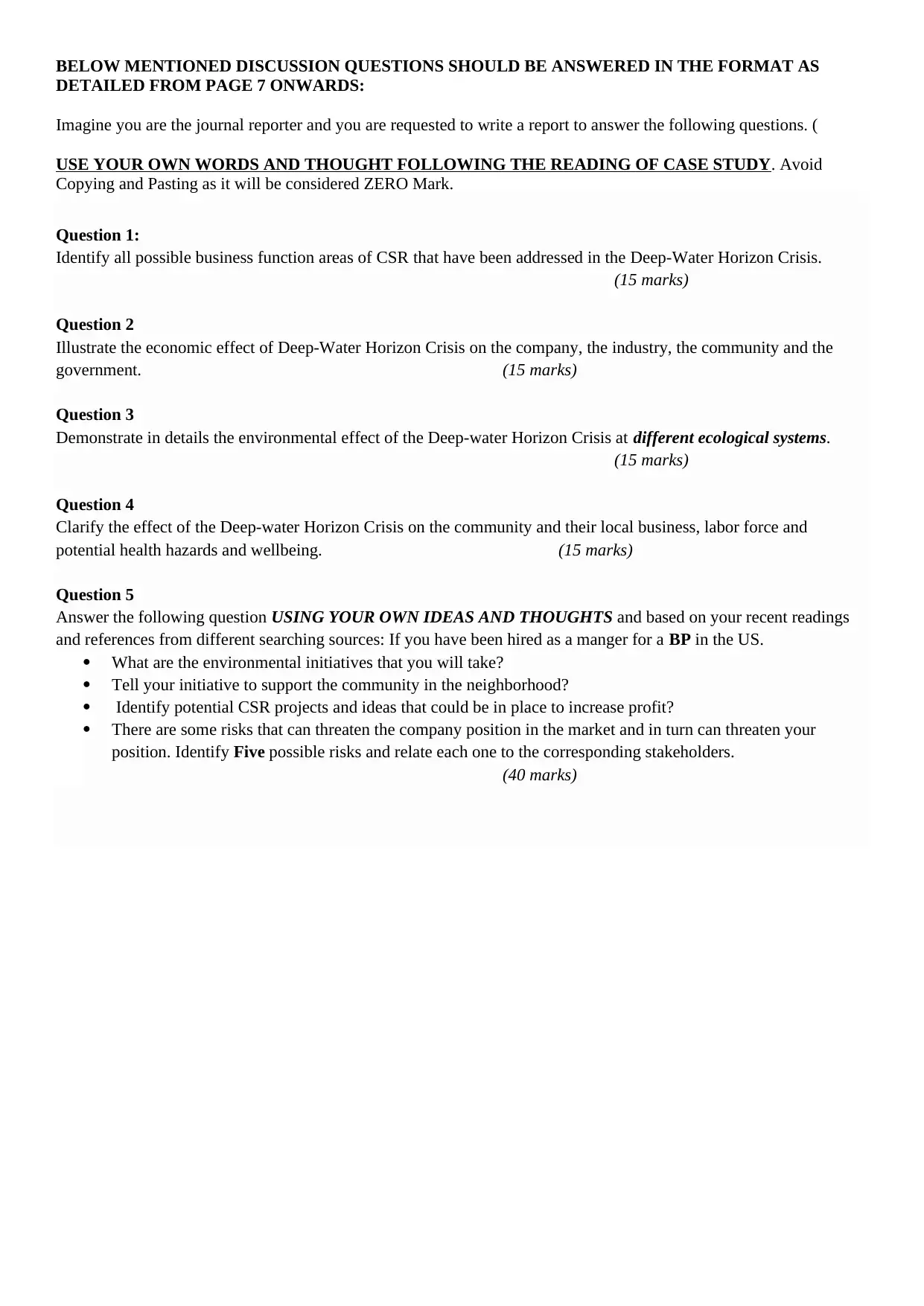
BELOW MENTIONED DISCUSSION QUESTIONS SHOULD BE ANSWERED IN THE FORMAT AS
DETAILED FROM PAGE 7 ONWARDS:
Imagine you are the journal reporter and you are requested to write a report to answer the following questions. (
USE YOUR OWN WORDS AND THOUGHT FOLLOWING THE READING OF CASE STUDY. Avoid
Copying and Pasting as it will be considered ZERO Mark.
Question 1:
Identify all possible business function areas of CSR that have been addressed in the Deep-Water Horizon Crisis.
(15 marks)
Question 2
Illustrate the economic effect of Deep-Water Horizon Crisis on the company, the industry, the community and the
government. (15 marks)
Question 3
Demonstrate in details the environmental effect of the Deep-water Horizon Crisis at different ecological systems.
(15 marks)
Question 4
Clarify the effect of the Deep-water Horizon Crisis on the community and their local business, labor force and
potential health hazards and wellbeing. (15 marks)
Question 5
Answer the following question USING YOUR OWN IDEAS AND THOUGHTS and based on your recent readings
and references from different searching sources: If you have been hired as a manger for a BP in the US.
What are the environmental initiatives that you will take?
Tell your initiative to support the community in the neighborhood?
Identify potential CSR projects and ideas that could be in place to increase profit?
There are some risks that can threaten the company position in the market and in turn can threaten your
position. Identify Five possible risks and relate each one to the corresponding stakeholders.
(40 marks)
DETAILED FROM PAGE 7 ONWARDS:
Imagine you are the journal reporter and you are requested to write a report to answer the following questions. (
USE YOUR OWN WORDS AND THOUGHT FOLLOWING THE READING OF CASE STUDY. Avoid
Copying and Pasting as it will be considered ZERO Mark.
Question 1:
Identify all possible business function areas of CSR that have been addressed in the Deep-Water Horizon Crisis.
(15 marks)
Question 2
Illustrate the economic effect of Deep-Water Horizon Crisis on the company, the industry, the community and the
government. (15 marks)
Question 3
Demonstrate in details the environmental effect of the Deep-water Horizon Crisis at different ecological systems.
(15 marks)
Question 4
Clarify the effect of the Deep-water Horizon Crisis on the community and their local business, labor force and
potential health hazards and wellbeing. (15 marks)
Question 5
Answer the following question USING YOUR OWN IDEAS AND THOUGHTS and based on your recent readings
and references from different searching sources: If you have been hired as a manger for a BP in the US.
What are the environmental initiatives that you will take?
Tell your initiative to support the community in the neighborhood?
Identify potential CSR projects and ideas that could be in place to increase profit?
There are some risks that can threaten the company position in the market and in turn can threaten your
position. Identify Five possible risks and relate each one to the corresponding stakeholders.
(40 marks)
⊘ This is a preview!⊘
Do you want full access?
Subscribe today to unlock all pages.

Trusted by 1+ million students worldwide
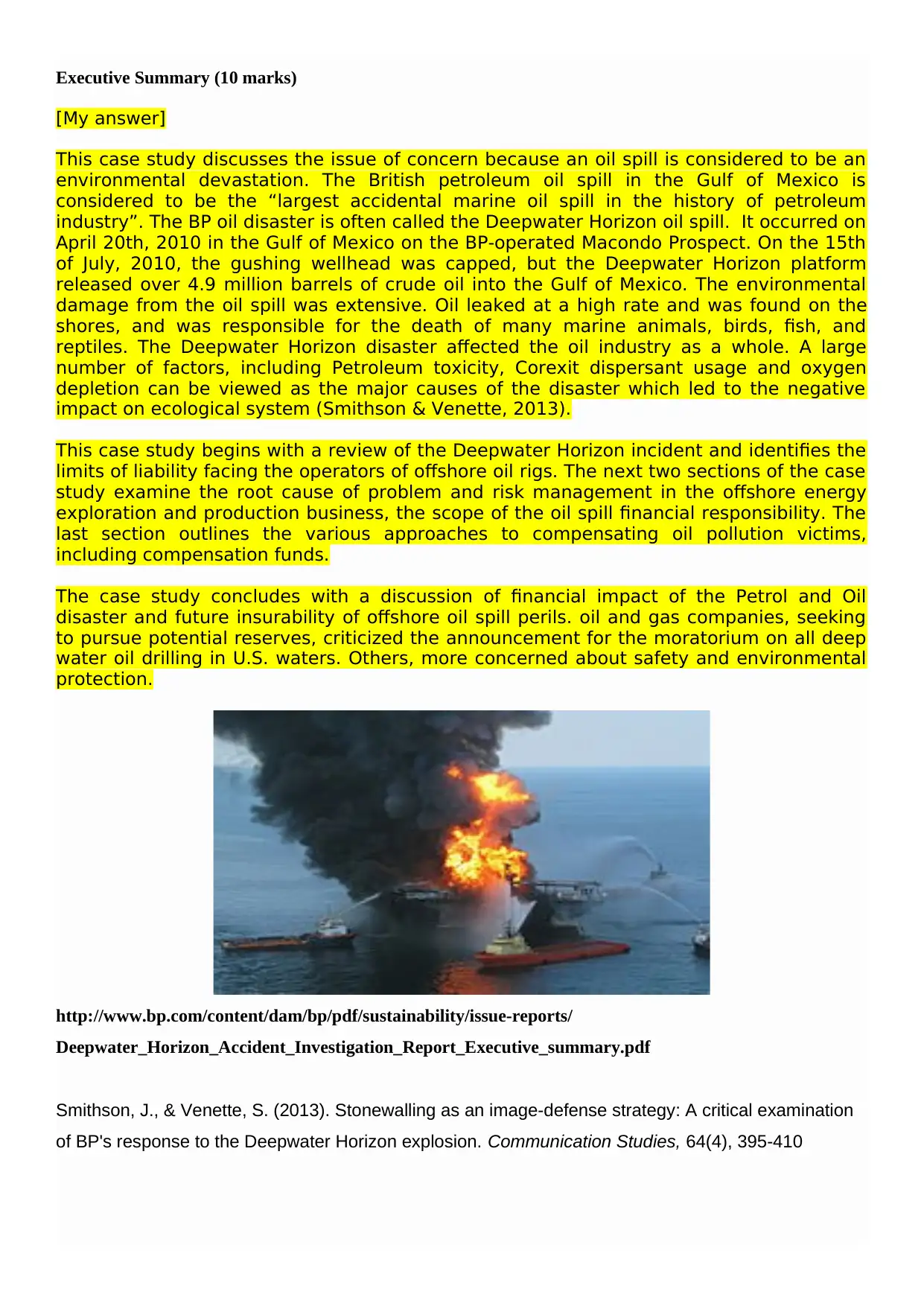
Executive Summary (10 marks)
[My answer]
This case study discusses the issue of concern because an oil spill is considered to be an
environmental devastation. The British petroleum oil spill in the Gulf of Mexico is
considered to be the “largest accidental marine oil spill in the history of petroleum
industry”. The BP oil disaster is often called the Deepwater Horizon oil spill. It occurred on
April 20th, 2010 in the Gulf of Mexico on the BP-operated Macondo Prospect. On the 15th
of July, 2010, the gushing wellhead was capped, but the Deepwater Horizon platform
released over 4.9 million barrels of crude oil into the Gulf of Mexico. The environmental
damage from the oil spill was extensive. Oil leaked at a high rate and was found on the
shores, and was responsible for the death of many marine animals, birds, fish, and
reptiles. The Deepwater Horizon disaster affected the oil industry as a whole. A large
number of factors, including Petroleum toxicity, Corexit dispersant usage and oxygen
depletion can be viewed as the major causes of the disaster which led to the negative
impact on ecological system (Smithson & Venette, 2013).
This case study begins with a review of the Deepwater Horizon incident and identifies the
limits of liability facing the operators of offshore oil rigs. The next two sections of the case
study examine the root cause of problem and risk management in the offshore energy
exploration and production business, the scope of the oil spill financial responsibility. The
last section outlines the various approaches to compensating oil pollution victims,
including compensation funds.
The case study concludes with a discussion of financial impact of the Petrol and Oil
disaster and future insurability of offshore oil spill perils. oil and gas companies, seeking
to pursue potential reserves, criticized the announcement for the moratorium on all deep
water oil drilling in U.S. waters. Others, more concerned about safety and environmental
protection.
http://www.bp.com/content/dam/bp/pdf/sustainability/issue-reports/
Deepwater_Horizon_Accident_Investigation_Report_Executive_summary.pdf
Smithson, J., & Venette, S. (2013). Stonewalling as an image-defense strategy: A critical examination
of BP's response to the Deepwater Horizon explosion. Communication Studies, 64(4), 395-410
[My answer]
This case study discusses the issue of concern because an oil spill is considered to be an
environmental devastation. The British petroleum oil spill in the Gulf of Mexico is
considered to be the “largest accidental marine oil spill in the history of petroleum
industry”. The BP oil disaster is often called the Deepwater Horizon oil spill. It occurred on
April 20th, 2010 in the Gulf of Mexico on the BP-operated Macondo Prospect. On the 15th
of July, 2010, the gushing wellhead was capped, but the Deepwater Horizon platform
released over 4.9 million barrels of crude oil into the Gulf of Mexico. The environmental
damage from the oil spill was extensive. Oil leaked at a high rate and was found on the
shores, and was responsible for the death of many marine animals, birds, fish, and
reptiles. The Deepwater Horizon disaster affected the oil industry as a whole. A large
number of factors, including Petroleum toxicity, Corexit dispersant usage and oxygen
depletion can be viewed as the major causes of the disaster which led to the negative
impact on ecological system (Smithson & Venette, 2013).
This case study begins with a review of the Deepwater Horizon incident and identifies the
limits of liability facing the operators of offshore oil rigs. The next two sections of the case
study examine the root cause of problem and risk management in the offshore energy
exploration and production business, the scope of the oil spill financial responsibility. The
last section outlines the various approaches to compensating oil pollution victims,
including compensation funds.
The case study concludes with a discussion of financial impact of the Petrol and Oil
disaster and future insurability of offshore oil spill perils. oil and gas companies, seeking
to pursue potential reserves, criticized the announcement for the moratorium on all deep
water oil drilling in U.S. waters. Others, more concerned about safety and environmental
protection.
http://www.bp.com/content/dam/bp/pdf/sustainability/issue-reports/
Deepwater_Horizon_Accident_Investigation_Report_Executive_summary.pdf
Smithson, J., & Venette, S. (2013). Stonewalling as an image-defense strategy: A critical examination
of BP's response to the Deepwater Horizon explosion. Communication Studies, 64(4), 395-410
Paraphrase This Document
Need a fresh take? Get an instant paraphrase of this document with our AI Paraphraser
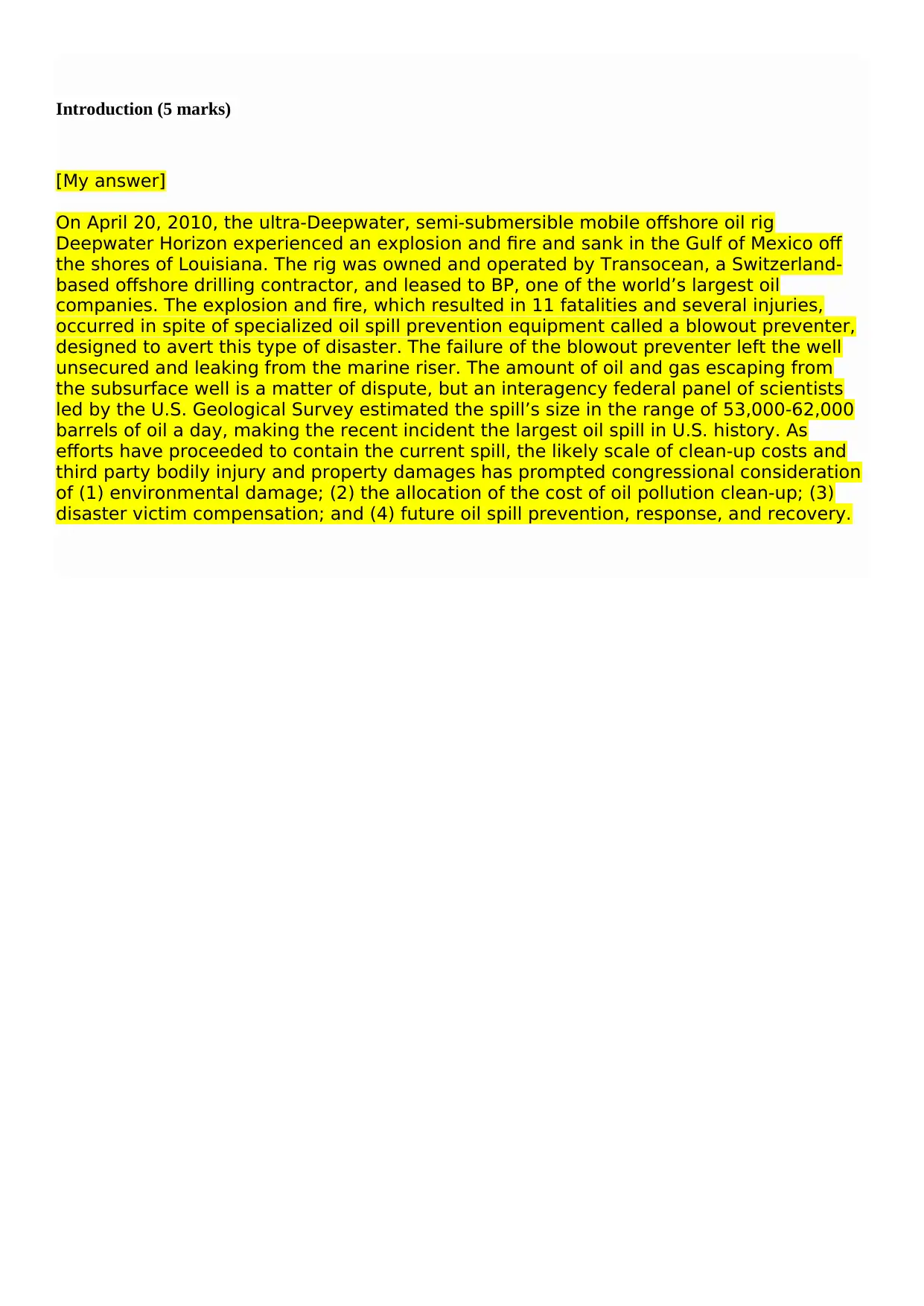
Introduction (5 marks)
[My answer]
On April 20, 2010, the ultra-Deepwater, semi-submersible mobile offshore oil rig
Deepwater Horizon experienced an explosion and fire and sank in the Gulf of Mexico off
the shores of Louisiana. The rig was owned and operated by Transocean, a Switzerland-
based offshore drilling contractor, and leased to BP, one of the world’s largest oil
companies. The explosion and fire, which resulted in 11 fatalities and several injuries,
occurred in spite of specialized oil spill prevention equipment called a blowout preventer,
designed to avert this type of disaster. The failure of the blowout preventer left the well
unsecured and leaking from the marine riser. The amount of oil and gas escaping from
the subsurface well is a matter of dispute, but an interagency federal panel of scientists
led by the U.S. Geological Survey estimated the spill’s size in the range of 53,000-62,000
barrels of oil a day, making the recent incident the largest oil spill in U.S. history. As
efforts have proceeded to contain the current spill, the likely scale of clean-up costs and
third party bodily injury and property damages has prompted congressional consideration
of (1) environmental damage; (2) the allocation of the cost of oil pollution clean-up; (3)
disaster victim compensation; and (4) future oil spill prevention, response, and recovery.
[My answer]
On April 20, 2010, the ultra-Deepwater, semi-submersible mobile offshore oil rig
Deepwater Horizon experienced an explosion and fire and sank in the Gulf of Mexico off
the shores of Louisiana. The rig was owned and operated by Transocean, a Switzerland-
based offshore drilling contractor, and leased to BP, one of the world’s largest oil
companies. The explosion and fire, which resulted in 11 fatalities and several injuries,
occurred in spite of specialized oil spill prevention equipment called a blowout preventer,
designed to avert this type of disaster. The failure of the blowout preventer left the well
unsecured and leaking from the marine riser. The amount of oil and gas escaping from
the subsurface well is a matter of dispute, but an interagency federal panel of scientists
led by the U.S. Geological Survey estimated the spill’s size in the range of 53,000-62,000
barrels of oil a day, making the recent incident the largest oil spill in U.S. history. As
efforts have proceeded to contain the current spill, the likely scale of clean-up costs and
third party bodily injury and property damages has prompted congressional consideration
of (1) environmental damage; (2) the allocation of the cost of oil pollution clean-up; (3)
disaster victim compensation; and (4) future oil spill prevention, response, and recovery.
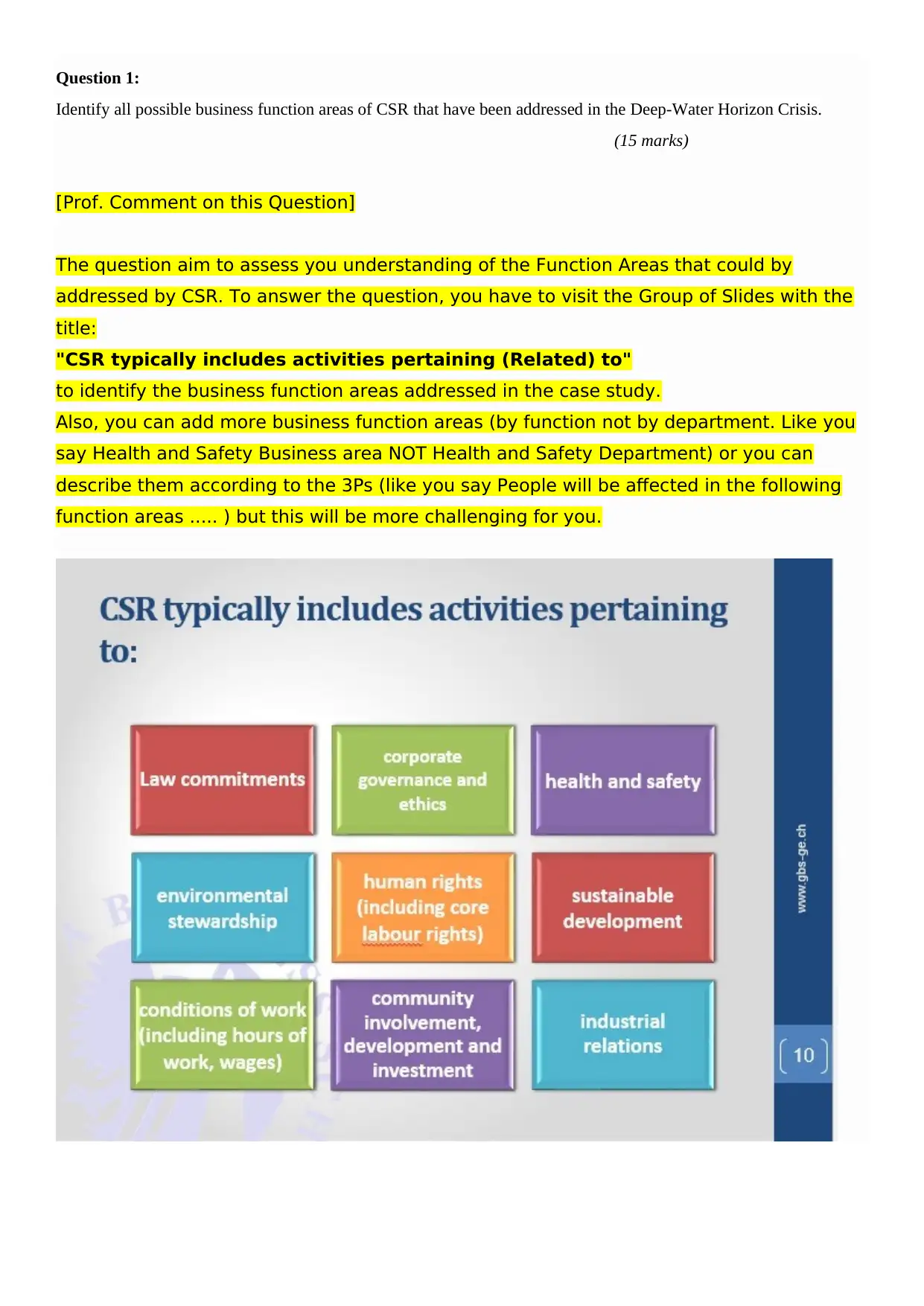
Question 1:
Identify all possible business function areas of CSR that have been addressed in the Deep-Water Horizon Crisis.
(15 marks)
[Prof. Comment on this Question]
The question aim to assess you understanding of the Function Areas that could by
addressed by CSR. To answer the question, you have to visit the Group of Slides with the
title:
"CSR typically includes activities pertaining (Related) to"
to identify the business function areas addressed in the case study.
Also, you can add more business function areas (by function not by department. Like you
say Health and Safety Business area NOT Health and Safety Department) or you can
describe them according to the 3Ps (like you say People will be affected in the following
function areas ..... ) but this will be more challenging for you.
Identify all possible business function areas of CSR that have been addressed in the Deep-Water Horizon Crisis.
(15 marks)
[Prof. Comment on this Question]
The question aim to assess you understanding of the Function Areas that could by
addressed by CSR. To answer the question, you have to visit the Group of Slides with the
title:
"CSR typically includes activities pertaining (Related) to"
to identify the business function areas addressed in the case study.
Also, you can add more business function areas (by function not by department. Like you
say Health and Safety Business area NOT Health and Safety Department) or you can
describe them according to the 3Ps (like you say People will be affected in the following
function areas ..... ) but this will be more challenging for you.
⊘ This is a preview!⊘
Do you want full access?
Subscribe today to unlock all pages.

Trusted by 1+ million students worldwide
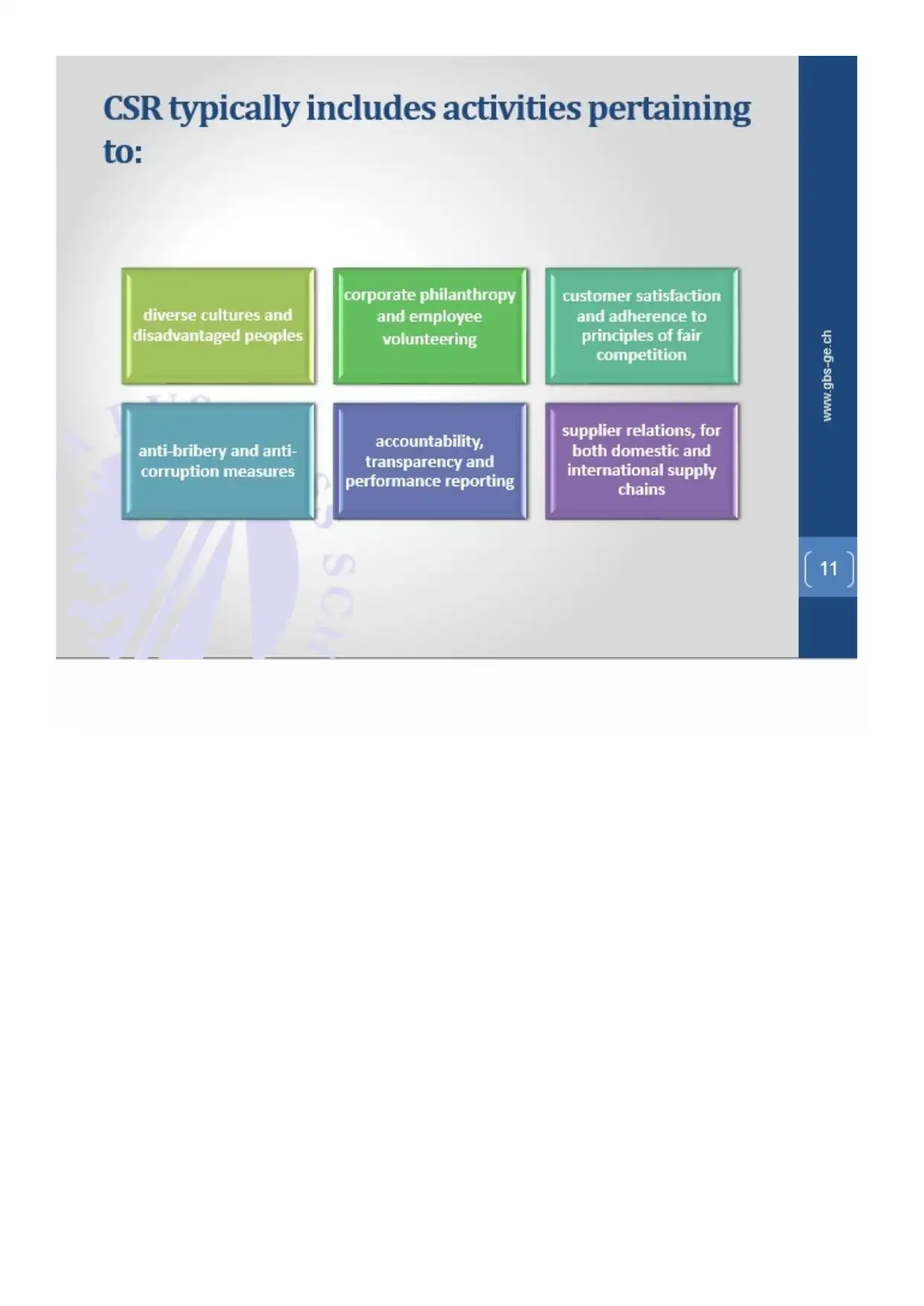
Paraphrase This Document
Need a fresh take? Get an instant paraphrase of this document with our AI Paraphraser

Question 2
Illustrate the economic effect of Deep-Water Horizon Crisis on the company, the industry, the community and the
government. (15 marks)
Illustrate the economic effect of Deep-Water Horizon Crisis on the company, the industry, the community and the
government. (15 marks)

Question 3
Demonstrate in details the environmental effect of the Deep-water Horizon Crisis at different ecological systems.
(15 marks)
Demonstrate in details the environmental effect of the Deep-water Horizon Crisis at different ecological systems.
(15 marks)
⊘ This is a preview!⊘
Do you want full access?
Subscribe today to unlock all pages.

Trusted by 1+ million students worldwide
1 out of 18
Related Documents
Your All-in-One AI-Powered Toolkit for Academic Success.
+13062052269
info@desklib.com
Available 24*7 on WhatsApp / Email
![[object Object]](/_next/static/media/star-bottom.7253800d.svg)
Unlock your academic potential
Copyright © 2020–2025 A2Z Services. All Rights Reserved. Developed and managed by ZUCOL.





